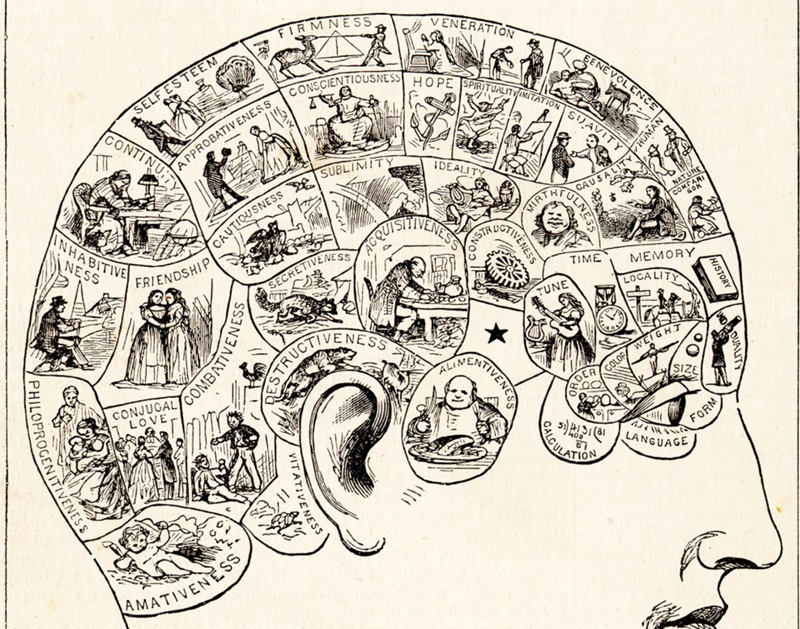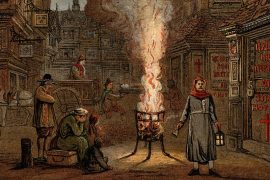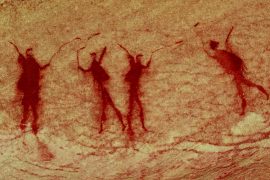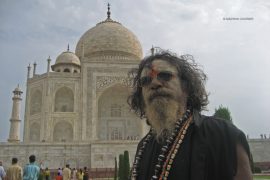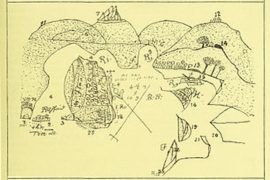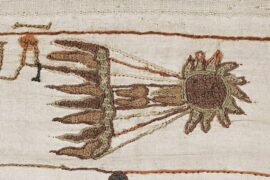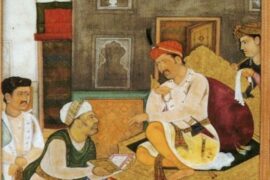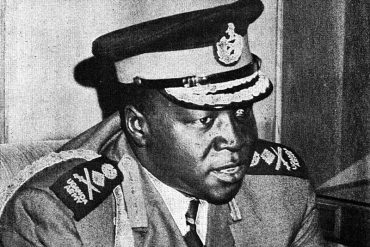A room at the University of Edinburgh’s Medical School has a collection of hundreds of human skulls from around the world; some are disintegrating but still have skin and hair attached to them. These skulls were collected specifically for a ‘study’ using an absurd pseudoscience called Phrenology.
Phrenology was a pseudoscience founded in the early nineteenth century by a German physiologist, Franz Joseph Gall. It studied the size and shape of skulls to ‘understand’ a person’s mental abilities. For example, Gal deduced that a criminal convicted of murder would show certain traits, bumps, or protrusions at specific areas on their head, which ostensibly explained their tendencies towards violence. There was no evidence to support his argument. Regardless, he endeavoured to prove it on those terms.
Gall hypothesised that the brain was made up of multiple’ organs.’ Each organ, he theorised, was related to various human characteristics or abilities. Since the skull housed the brain, he deduced that the ‘shape, size, and geography of the skull’ could help understand these ‘organs,’ which, in turn, ‘helped to understand the person’s mental capacity.’
This pseudoscience divided the mind into two parts: ‘feelings’ and ‘intellectual faculties.’ Feelings were further divided into ‘propensities,’ which included ‘combativeness,’ ‘destructiveness’ or ‘secretiveness,’ and ‘sentiments,’ which were made up of ‘veneration,’ ‘firmness’ and ‘hope.’
Furthermore, he theorised that ‘propensities’ could be concluded by observing the back of the brain and that sentiments could be studied by examining the head’s crown. He attributed ‘intellectual faculties’ to ‘senses and perception of knowledge,’ which, ostensibly, could be ‘observed at the front of the skull—from the hairline to the bottom of the eyes.’
Amongst the collection of skulls at the University of Edinburgh were seven skulls from India. These skulls belonged to ‘Dirgpaul,’ ‘Gunga Bishun,’ ‘Soopher Sing,’ ‘Hosein Alee Khan,’ ‘Keramut Khan,’ ‘Buksha,’ and ‘Golab Khan’—all of them were convicts who were executed.
Dr Henry Spry of the Bengal Medical Service severed their heads, boxed them up, and shipped them to George Combe in Edinburgh. The skulls also bore another word with their names: ‘thug.’ The Europeans had established—without evidence, of course—that people belonging to the ‘thuggee caste’ were ‘criminals,’ where criminal behaviour was passed down genetically through generations. Spry had also prepared a background note to explain their criminal actions; it was published as an article in the Phrenological Journal.
Robert Cox, a man who believed in Phrenology, had to present an analysis of the skulls to explain the tendencies of the ‘thugs.’ However, there was one problem: Cox couldn’t explain why ‘destructiveness,’ as Gall called the organ of murder, was just moderately developed. Cox presented the following argument as an explanation:
This fact [of an under-developed faculty of Destructiveness], although it might appear to a superficial observer in opposition to their character, is in reality perfectly consistent with it. When Destructiveness is the predominant organ in the head of an individual, he delights in taking away life from ‘ruffian thirst for blood’; but the thugs murdered obviously for the sake of robbing, and under the influence of other motives, to be immediately explained, and also because they had been trained to this mode of life from their infancy.
Cox suggested that many qualities of the Thugs were ‘common to their nationality and religion.’ Indians, he deduced, were characterised by wanting more children, jealousy, polygamy, and ‘unnatural desires.’
Others have also conducted ‘studies’ using this pseudoscience. Similar to Cox’s conclusions, they stereotyped Indians and deduced that they were an ‘inferior’ race. Many skulls from around the world were shipped to Britain and studied to publish ‘studies’ to prove that Caucasians were at the top of the racial hierarchy.
The development and popularity of Phrenology presented a ‘theory of national skulls,’ in which people of the same nation could be identified by similarities in characteristics, which could often be seen from similar patterns in the bone structures of skulls. While it was hard to prove, George Combe, known as a ‘pioneer of Phrenological society in the British Isles,’ suggested that since a nation was composed of an individual, the character study of an individual ‘must hold good of the whole.’
‘Phrenological studies’—born out of racial bias instead of evidence— came up with ridiculous, unsubstantiated suggestions. For instance, they suggested that Europeans had a ‘strong tendency towards moral and intellectual improvement’ and that Asians and Africans were ‘far inferior to the European standard.’ Consequently, they used these studies to justify colonialism and slavery.
Several studies of the brain’s size and shape were pursued during the time to proclaim the ‘European standard.’ Sir Herbery Hope Risley’s ‘anthropometry,’ a pseudo ‘technique’ with no scientific basis, was used to survey 30 individuals. He took the measurements of the cranium only to create a facade that there was a method to his study. However, he already knew what he was to conclude and fit his observations in a manner to present the racial composition of Indians. He concluded that seven racial types contributed to the composition of the Indian race: ‘the Mongoloid, the Dravidian, the Indo-Aryan, the Turko-Iranian, the Mongolo-Dravidian, the Aryo-Dravidian, and the Scytho-Dravidian.’
Dr. George Murray Paterson, an assistant surgeon at the Bengal Medical Services, spent hours and weeks arranging and rearranging different types of skulls on a table in his Calcutta house to suggest that the Caucasians were superior. Furthermore, they used these studies to claim the ‘superiority’ of Christianity. He even asserted that conversion to Christianity could change the structure of the skull to close the difference between ‘coloured’ and Caucasian people.
However, others who were equally racist challenged such assertions. Moreover, as the conclusions were inconsistent, the theory did not find a unified voice. In his ‘Essay on Phrenology of the Hindoos and Negroes,’ James Montgomery, a philanthropist and phrenological sceptic, concluded that while Indians were ‘distinguished by their mental and bodily imbecility,’ the Africans were ‘the most inferior in comparison to any other species of genuine men.’
Several volumes published between 1839 and 1849 using this pseudoscience affirmed that the Caucasian race was the most intelligent. Behind them were the American Indians, followed by Hindus (as all Indians were referred to). At the bottom of the hierarchy were Black Africans.
Phrenology, the pseudoscience, attempted to link the culture to the physical features. Sadly, many Europeans believed in their own lies and succumbed to their false sense of superiority. It resulted not only in the trade of skulls but also stressed how the European brains were ‘larger, better formed and better balanced.’
The use of Phrenology, a pseudoscience sans evidence, to justify racism, colonialism and slavery is just one of the many instances of how human ignorance, cloaked as science, paved the way for inequity and oppression. Far from showcasing the superiority of Caucasians, the skulls at the University of Edinburgh are reminiscent of the stupidity of the European colonialists.
-30-
Copyright©Madras Courier, All Rights Reserved. You may share using our article tools. Please don't cut articles from madrascourier.com and redistribute by email, post to the web, mobile phone or social media.Please send in your feed back and comments to [email protected]

